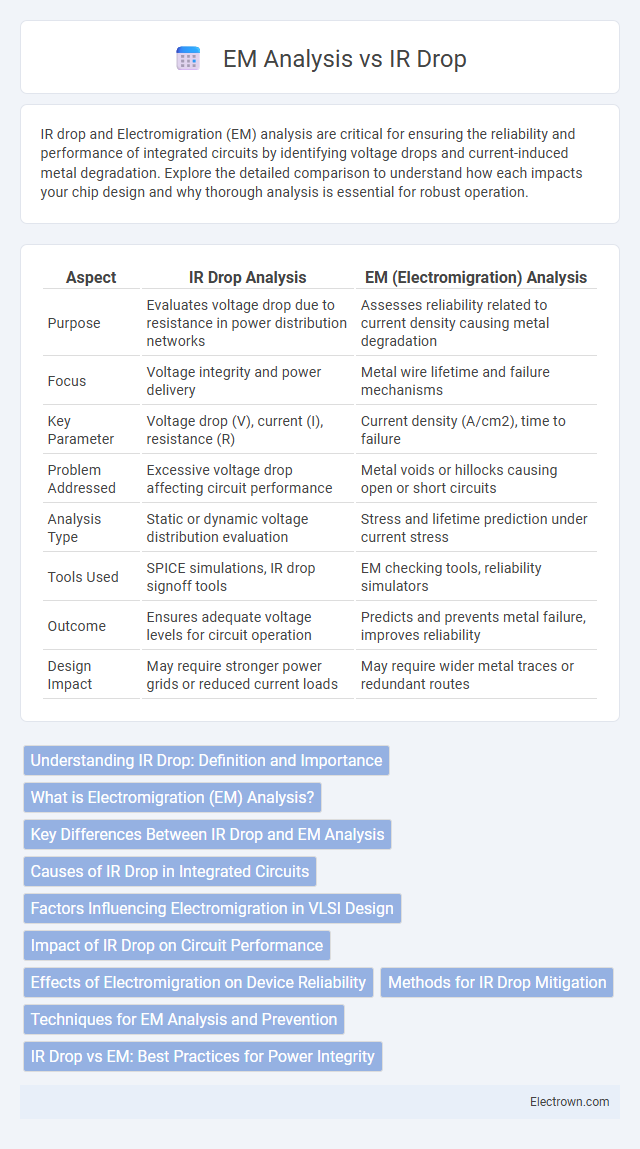IR drop and Electromigration (EM) analysis are critical for ensuring the reliability and performance of integrated circuits by identifying voltage drops and current-induced metal degradation. Explore the detailed comparison to understand how each impacts your chip design and why thorough analysis is essential for robust operation.
Table of Comparison
| Aspect | IR Drop Analysis | EM (Electromigration) Analysis |
|---|---|---|
| Purpose | Evaluates voltage drop due to resistance in power distribution networks | Assesses reliability related to current density causing metal degradation |
| Focus | Voltage integrity and power delivery | Metal wire lifetime and failure mechanisms |
| Key Parameter | Voltage drop (V), current (I), resistance (R) | Current density (A/cm2), time to failure |
| Problem Addressed | Excessive voltage drop affecting circuit performance | Metal voids or hillocks causing open or short circuits |
| Analysis Type | Static or dynamic voltage distribution evaluation | Stress and lifetime prediction under current stress |
| Tools Used | SPICE simulations, IR drop signoff tools | EM checking tools, reliability simulators |
| Outcome | Ensures adequate voltage levels for circuit operation | Predicts and prevents metal failure, improves reliability |
| Design Impact | May require stronger power grids or reduced current loads | May require wider metal traces or redundant routes |
Understanding IR Drop: Definition and Importance
IR Drop refers to the voltage loss caused by resistance in power delivery networks, significantly affecting circuit performance and reliability. Understanding IR Drop is crucial for accurate power integrity analysis, ensuring Your designs maintain sufficient voltage levels under operating conditions. Electromigration (EM) analysis complements IR Drop assessment by evaluating metal wire degradation due to current density, preventing premature failures.
What is Electromigration (EM) Analysis?
Electromigration (EM) Analysis evaluates the gradual movement of metal atoms in interconnects caused by high current density, which can lead to circuit failure. This technique identifies weak spots in your chip's metal lines to ensure long-term reliability and prevent open or short circuits. Compared to IR Drop analysis, which focuses on voltage drops, EM Analysis specifically targets material degradation under electrical stress.
Key Differences Between IR Drop and EM Analysis
IR Drop analysis assesses voltage drops across power delivery networks due to resistance under current flow, while EM (Electromigration) analysis evaluates the gradual movement of metal atoms in interconnects caused by high current densities. IR Drop focuses on voltage integrity to prevent functional failures, whereas EM analysis targets long-term reliability by predicting potential open or short circuits. Your design's power integrity strategy should balance both analyses to ensure stable operation and durability in semiconductor devices.
Causes of IR Drop in Integrated Circuits
IR drop in integrated circuits is primarily caused by voltage losses due to resistive elements in power delivery networks, including metal interconnects and bonding wires. High current density, long interconnect lengths, and insufficient metal widths exacerbate the voltage drop, leading to performance degradation or functional failure. Your design must carefully evaluate these factors through IR drop and EM analysis to ensure circuit reliability.
Factors Influencing Electromigration in VLSI Design
Electromigration (EM) in VLSI design is primarily influenced by current density, temperature, and material properties of interconnects, where higher current densities and elevated temperatures accelerate atomic diffusion leading to void formation. IR drop analysis contributes to identifying voltage drops causing localized heating, which exacerbates electromigration effects by increasing the stress on metal lines. Accurate modeling of these factors enables designers to optimize power delivery networks and improve the reliability of integrated circuits by mitigating electromigration-induced failures.
Impact of IR Drop on Circuit Performance
IR drop causes voltage degradation in power delivery networks, leading to reduced operational margins and increased timing violations in integrated circuits. Electromigration (EM) analysis examines the effect of current density on metal interconnect reliability, but IR drop primarily affects circuit speed and stability by lowering supply voltage levels. Accurate IR drop modeling is crucial to ensure signal integrity, prevent performance loss, and maintain overall chip functionality under varying load conditions.
Effects of Electromigration on Device Reliability
Electromigration (EM) induces atomic displacement in interconnect metals, causing increased resistance and potential open circuits, which critically degrades device reliability. IR drop analysis highlights voltage drops across power distribution networks but does not capture the cumulative material damage from EM, making EM analysis essential for predicting failure due to current density and temperature-induced stress. Comprehensive reliability assessment integrates IR drop evaluation with electromigration modeling to prevent performance degradation and extend device lifespan.
Methods for IR Drop Mitigation
IR Drop mitigation methods primarily involve optimizing power grid design by increasing metal layer widths and implementing additional power stripes or vias to reduce resistance. Advanced techniques such as dynamic voltage scaling and on-chip decoupling capacitors help maintain stable voltage levels under varying load conditions. You can also employ IR drop-aware routing algorithms during the physical design phase to ensure reliable power distribution throughout the chip.
Techniques for EM Analysis and Prevention
Electromigration (EM) analysis techniques primarily utilize finite element methods (FEM) and electro-thermal simulations to predict current density and temperature-induced atomic migration in interconnects. Prevention strategies involve optimizing metal line geometries, employing barrier layers, and using low-resistivity materials to reduce current crowding and thermal hotspots. Implementing redundant vias and stress-aware design rules further enhances interconnect reliability by mitigating EM-induced failures.
IR Drop vs EM: Best Practices for Power Integrity
IR drop analysis identifies voltage drops across the power distribution network that can cause performance degradation, making it essential for maintaining stable power delivery in integrated circuits. Electromigration (EM) analysis evaluates the reliability of metal interconnects under high current density to prevent circuit failures over time. Best practices for power integrity involve combining IR drop and EM analysis early in the design process to optimize metal routing, minimize resistance, and ensure robust current capacity while adhering to design rules and thermal limits.
IR Drop vs EM Analysis Infographic

 electrown.com
electrown.com